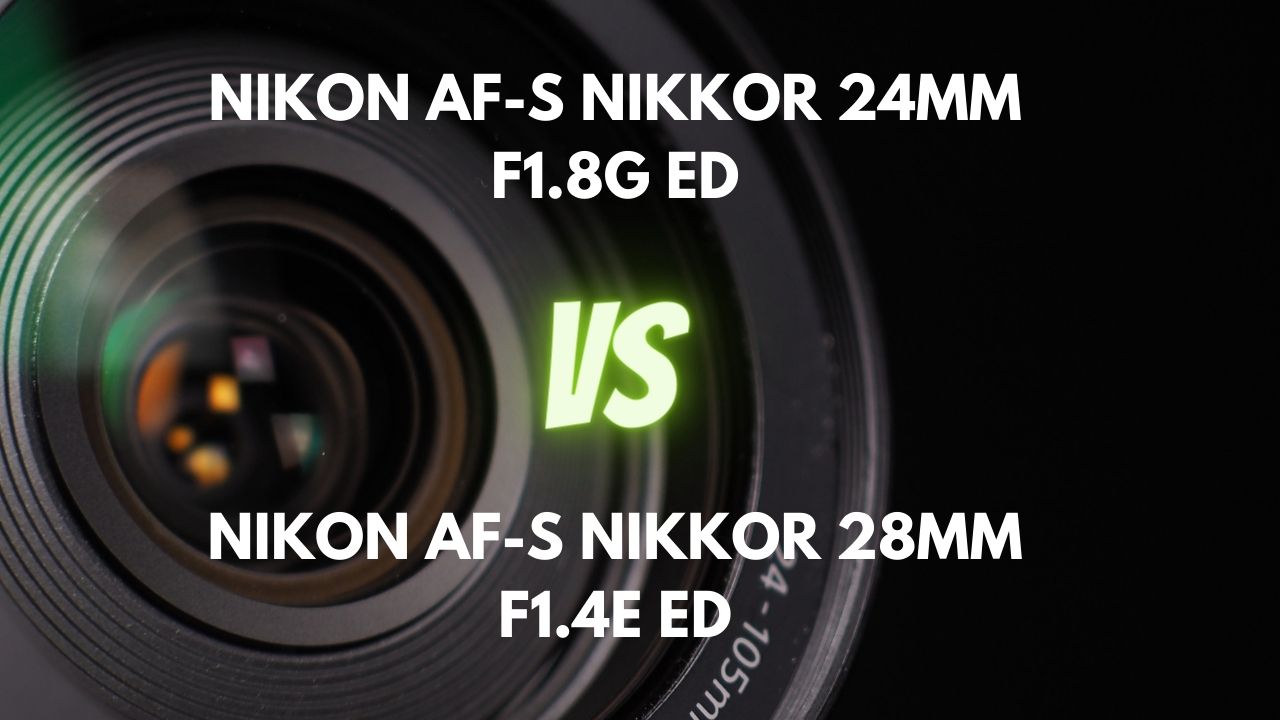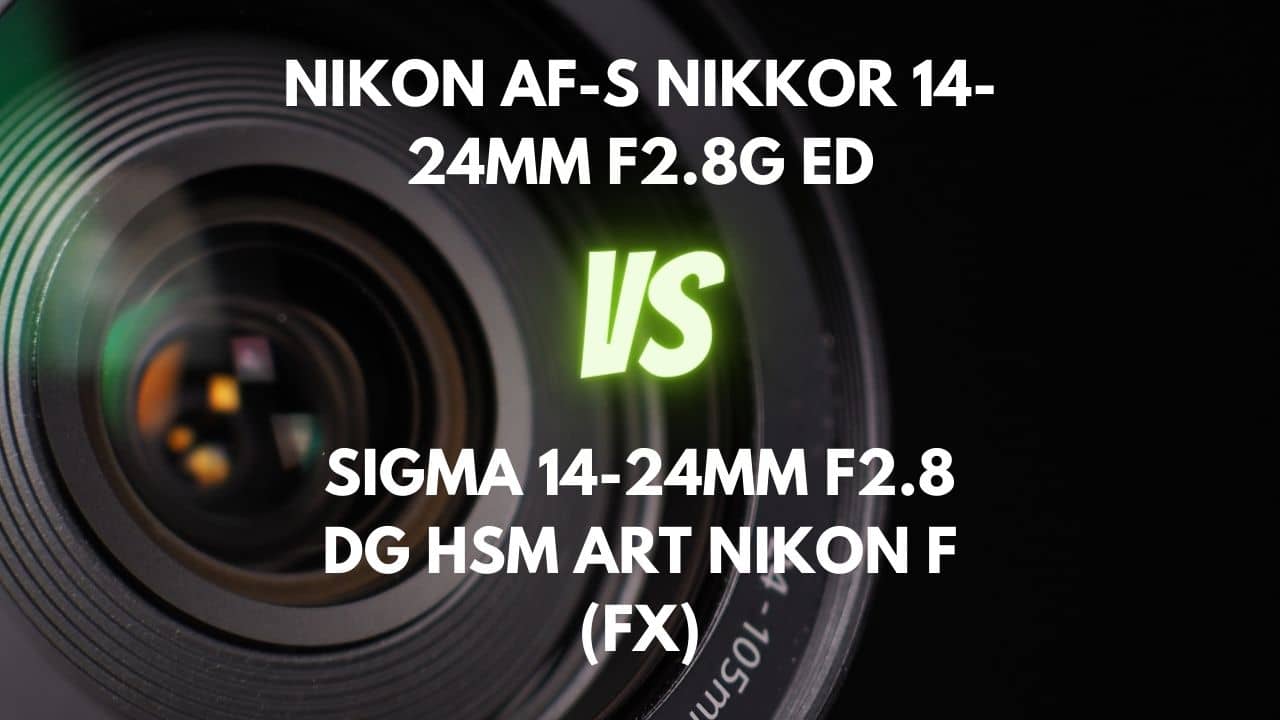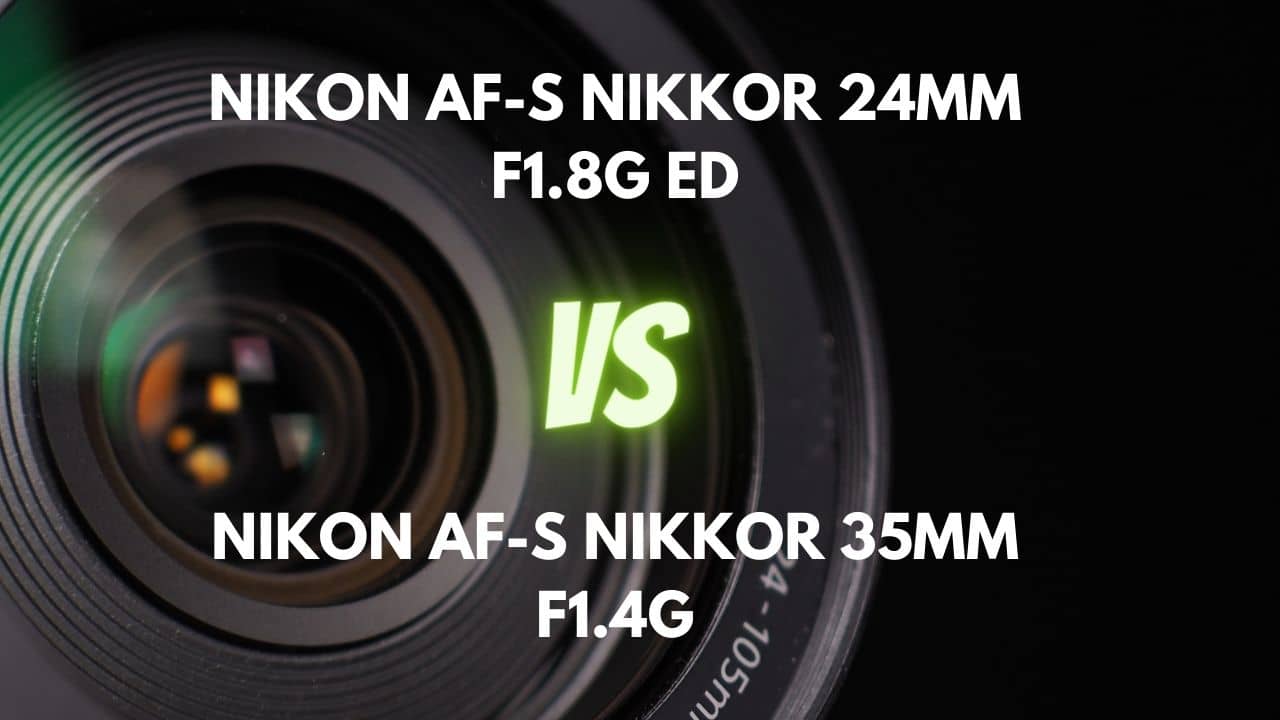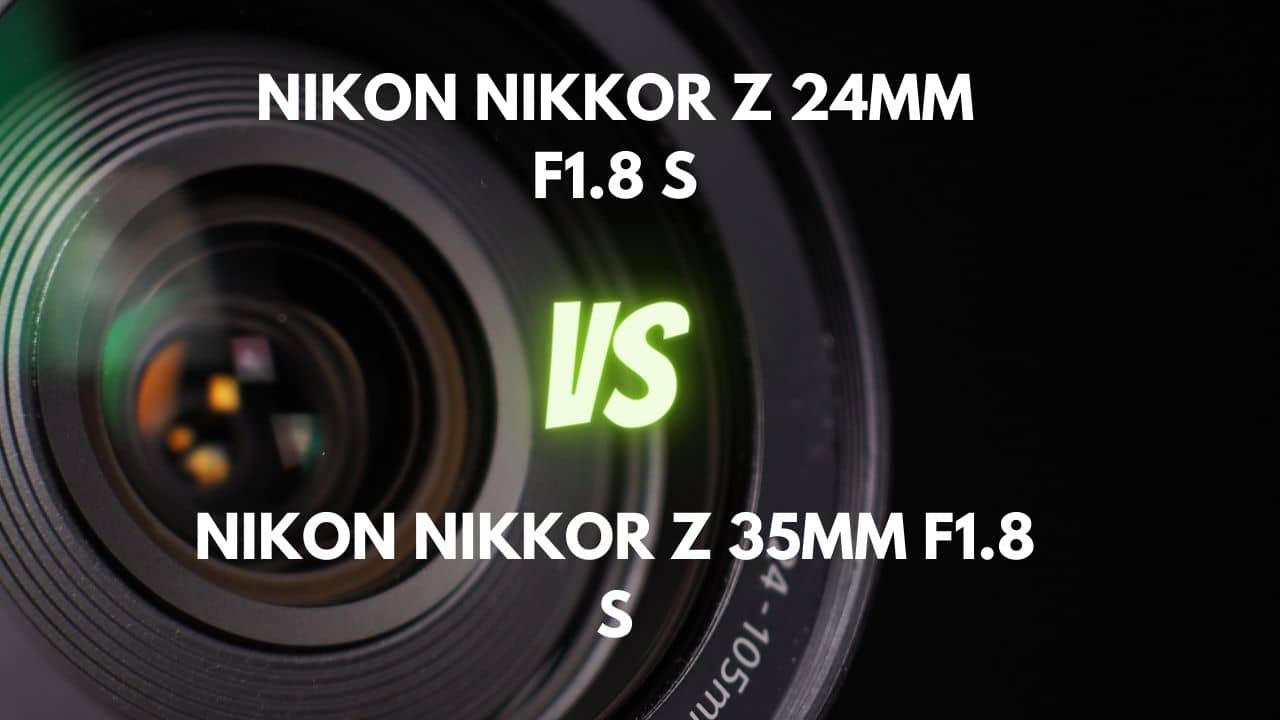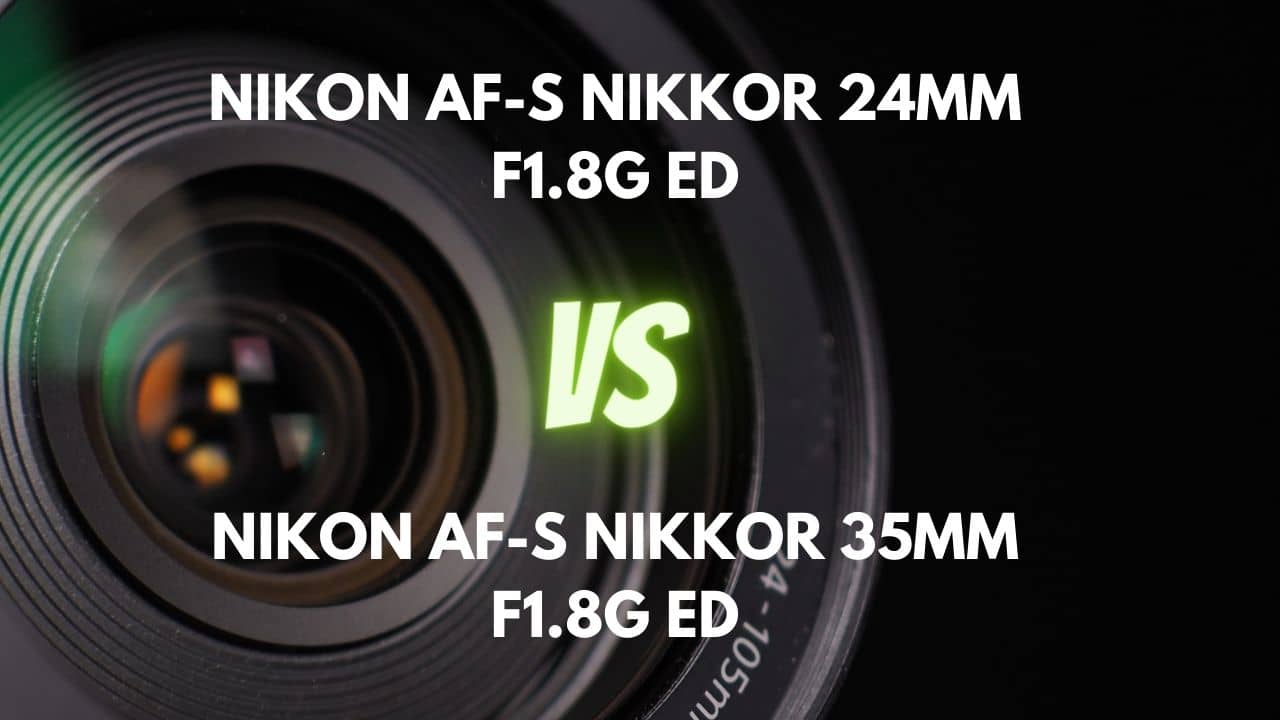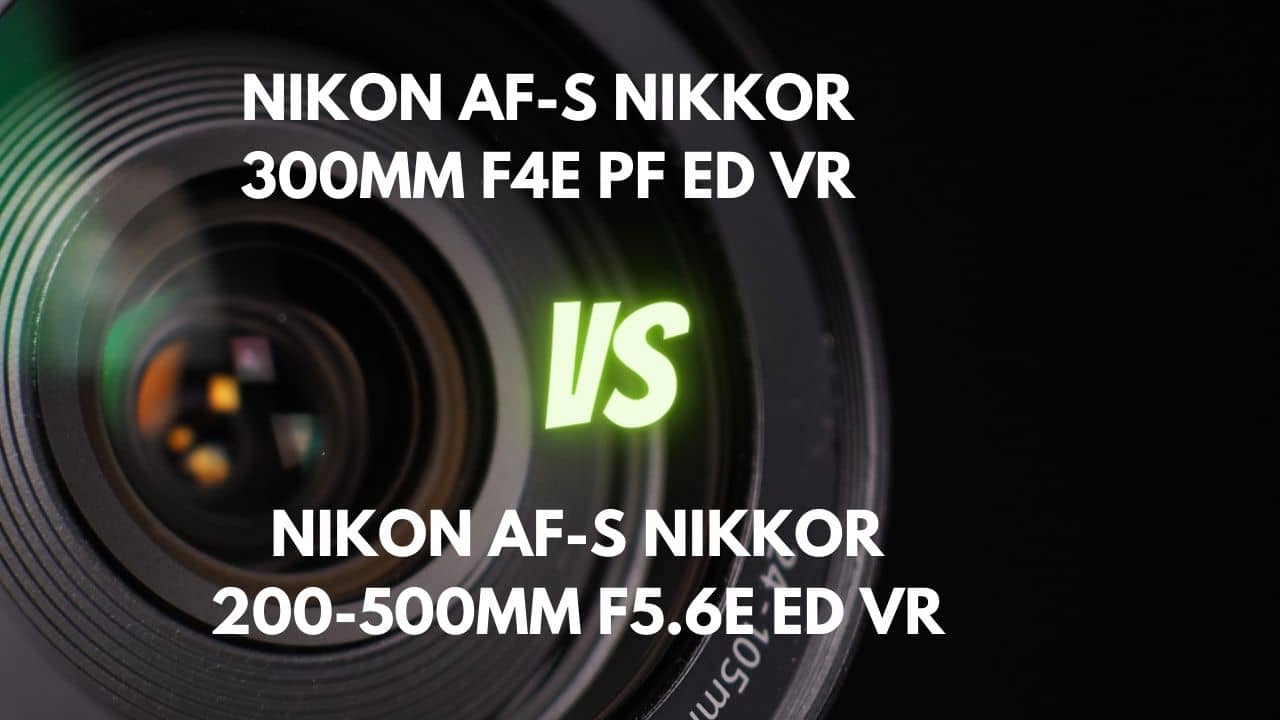Capturing the world through a lens is an art that requires the right tools.
If you’re a photographer seeking to explore the expansive vistas of landscape photography, delve into the intricacies of architectural structures, capture the celestial wonders of astrophotography, or freeze in time the moments of environmental portraiture, the choice of your lens becomes pivotal. In this fascinating world of photography, two wide-angle lenses have emerged as contenders in the race for superiority – the Nikon 24mm f/1.8 and the Sigma 24mm f/1.4.
The world of photography is as diverse as the lenses designed to capture it, and as photographers, we know that not all lenses are created equal. So, if you’re standing at the crossroads of the Nikon and Sigma lenses, our in-depth comparison might just shine the light on your path to making the best decision.
In our thorough exploration of these two lenses, we consider essential aspects like sharpness, distortion, bokeh, weather sealing, and more. Armed with this knowledge, you’ll not only better understand these lenses but also gain insights into how they can best serve your unique photographic needs.
So, whether you’re an experienced photographer looking to add another lens to your arsenal or a beginner seeking to understand the nuances of lens performance, this comparison offers a treasure trove of valuable insights. Embark on this journey with us as we unravel the features and performance of these two widely admired lenses, and find out which one could be the right choice for your photography adventures.
Let’s dive in!
Overview
| Nikon AF-S NIKKOR 24mm F1.8G ED | Sigma 24mm F1.4 DG HSM Art Nikon F (FX) | |
|---|---|---|
| Max Aperture | F1.8 | F1.4 |
| Aperture Type | Fixed | Fixed |
| Focal Range (mm) | 24 | 24 |
| Mount Type | Nikon F (FX) | Nikon F (FX) |
| Max Format | 35mm FF | 35mm FF |
Starting with the Nikon 24mm f/1.8, we note that it has a maximum aperture of f/1.8. A wider aperture like this allows more light to enter the camera, which is beneficial for shooting in low-light conditions. However, it should be remembered that the choice of aperture depends on the specific requirements and intended use of the lens. For instance, in landscape and architectural photography, a deeper depth of field is often required to keep the entire scene in focus, making a larger aperture less critical.
The Nikon lens is a fixed aperture lens which means that its aperture remains the same throughout all focal lengths, enhancing its performance in lower light conditions, and generally providing better image quality, such as sharpness, contrast, and reduced chromatic aberration. However, fixed aperture lenses are typically heavier, larger and more expensive than variable aperture lenses, which is something to consider if portability and budget are important factors for you.
Its focal range is 24mm, which indicates that it’s a wide-angle lens. This is ideal for shooting landscapes, architecture, or any scene where a broad field of view is required. Since it’s a prime lens, you’re limited to this focal length, which can push you to be more creative with your compositions.
Now, let’s move on to the Sigma 24mm f/1.4. This lens stands out due to its even wider maximum aperture of f/1.4. In theory, this wider aperture should offer superior low-light performance compared to the Nikon lens, and enable a shallower depth of field for more pronounced subject isolation. However, the greater aperture can potentially introduce more distortion or vignetting, especially at the widest focal lengths.
Like the Nikon lens, the Sigma is also a fixed aperture lens, bringing similar benefits in terms of consistent low-light performance and image quality across the focal range, despite its larger size, weight, and potentially higher cost.
The Sigma lens also shares the same focal range of 24mm as the Nikon lens, giving it similar capabilities in terms of field of view. As it’s also a prime lens, the same comments apply about its potential for boosting creativity through its fixed focal length.
In conclusion, both lenses have their merits. They share a lot in common, being prime wide-angle lenses with fixed apertures and a 24mm focal length. The primary difference lies in their maximum aperture, with the Sigma lens having the edge in potential low-light performance and depth of field control due to its wider f/1.4 aperture. However, the Nikon’s f/1.8 is still a fairly wide aperture and may offer a better balance of performance, distortion control, and potentially cost. Therefore, the superior lens will largely depend on your specific needs and preferences. If low-light performance and shallow depth of field are your top priorities, you might lean towards the Sigma lens. However, if you prefer a potential balance in overall image quality, the Nikon lens may be the more suitable choice.
Design and Ease of Use
| Nikon AF-S NIKKOR 24mm F1.8G ED | Sigma 24mm F1.4 DG HSM Art Nikon F (FX) | |
|---|---|---|
| Diameter x Length (mm) | ⌀77.5×83mm | ⌀85×90mm |
| Weight (gr) | 355 | 665 |
| Filter Thread (mm) | 72 | 77 |
| Weather Sealing | No | No |
| Distance Scale | Yes | Yes |
| DoF Scale | Yes | No |
| Hood Supplied | Yes | Yes |
Starting with the Nikon 24mm f/1.8, it has a diameter of 77.5mm and length of 83mm. Its relatively compact size can make it a more convenient choice for photographers who value portability and ease of storage. Being compact and lightweight also makes a lens easier to handle, especially when changing lenses quickly in dynamic shooting environments. The Nikon lens weighs in at 355 grams, which adds to its advantage in terms of portability and ease of use.
A lighter lens like the Nikon can also provide a better balance when mounted on a camera, especially for smaller camera bodies. This can lead to less physical strain during long shooting sessions. Furthermore, in certain photography genres like street photography, having a smaller and lighter lens can help you blend in more easily, allowing you to capture candid shots without attracting too much attention.
Moving onto the Sigma 24mm f/1.4, it is considerably larger with a diameter of 85mm and length of 90mm. It’s also significantly heavier, weighing 665 grams. The larger size and weight could potentially offer a more robust feel and might be preferred by some photographers for its potential stability and damping of minor shakes or vibrations.
However, these same characteristics might also make the Sigma lens less comfortable to carry around for extended periods, and it could cause your camera setup to feel front-heavy and unbalanced, particularly with smaller camera bodies. The greater weight and size could also be a factor when changing lenses quickly or carrying multiple lenses in your bag.
In conclusion, if portability, ease of handling, and discreetness are your main considerations, then the Nikon lens would be the superior choice due to its smaller size and lighter weight. On the other hand, if you prefer a larger, heavier lens that might offer greater stability, and if the size and weight are not major concerns for you, then you might prefer the Sigma lens.
Lens Mount and Barrel
Starting with the Nikon 24mm f/1.8, its lens mount is crafted from robust metal which guarantees a strong and secure attachment to the camera body. This durable construction is particularly suitable for heavy professional use, where frequent lens changes and rigorous handling are common. It also benefits from a rubber gasket that surrounds the mount, enhancing its defense against dust, moisture, and other potential elements that could damage the camera or lens. This makes it an excellent choice for photographers working in challenging environments.
On the other hand, the Sigma 24mm f/1.4 is constructed with a high-grade brass lens mount, which also provides a sturdy connection to the camera. This lens is compatible with Sigma’s optional USB dock for firmware updates and customization. However, a significant drawback is the absence of a rubber gasket, leaving it more susceptible to external contaminants like dust and moisture.
Shifting to the lens barrel, the Nikon lens employs durable plastic material that offers a lightweight feel without compromising durability. The use of plastic keeps the weight down, providing a comfortable shooting experience, especially with lighter DSLR cameras. The sleek finish and constant length during zooming or focusing enhance the lens’s aesthetics and practicality.
Conversely, the Sigma lens barrel boasts a Thermally Stable Composite (TSC) construction, a tough plastic variant renowned for its reliable performance across varying temperatures. Complemented with metal in some parts, this lens ensures enhanced durability and strength. The mix of matte and gloss black finish, coupled with sharply ribbed rubber rings, add to the aesthetic appeal while offering a comfortable and secure grip.
In the final analysis, the choice of lens will depend on your priorities. If you value a sturdy mount with weather sealing and a lightweight barrel for ease of handling, the Nikon lens’s construction proves superior. However, if the robustness of a brass mount, combined with the durability and temperature stability of a TSC lens barrel is your preference, the Sigma lens stands out.
Weather Sealing
The Nikon 24mm f/1.8 features a partial weather sealing design, specifically through the incorporation of a rubber gasket around the lens mount. This gasket serves to hinder dust and moisture from infiltrating the camera or lens body, which is a highly valued feature particularly in adverse conditions, like a dusty environment or a drizzle. However, it’s important to underline that this gasket, while offering some level of weather resistance, doesn’t translate into the lens being fully weather-sealed. Consequently, you should still exercise caution when using this lens in tough environments. Adding a UV filter to the front can provide an extra layer of defense against potential damage.
On the contrary, the Sigma 24mm f/1.4 does not come equipped with full weather sealing. Despite its durable construction, it lacks the protective measures found in fully weather-sealed lenses. Notably absent is a gasket at the lens mount, an element that serves to ward off dust, moisture, and other debris from entering the lens-camera interface. The lens also lacks internal seals at the rings, switches, and the front of the barrel. Therefore, it’s crucial to be extra cautious when utilizing this lens in challenging weather conditions to prevent possible damage.
From the perspective of weather sealing, the Nikon lens offers a superior degree of protection due to its inclusion of a rubber gasket around the lens mount. However, both lenses will require careful use and potential additional protection when deployed in adverse environmental conditions. So, while weather sealing can provide a level of comfort and peace of mind in unpredictable outdoor shoots, your unique photography needs and environments will ultimately dictate which lens’s weather sealing capabilities suit you best.
Rings
The Nikon 24mm f/1.8 comes with a broad, ridged focus ring occupying approximately half of the lens body, ensuring a secure grip and facilitating effortless manual focus operation. Conveniently positioned at the front of the lens barrel, the focus ring is rubbery and features a ribbed design, providing a tangible sensation and improved grip. This ring operates smoothly with minimal effort, although there is a small amount of slack, causing a slight delay between ring rotation and actual lens focus. This could make precise focus adjustments slightly challenging, especially at larger apertures.
However, the lens compensates with a brief overall focus throw, meaning the ring doesn’t need much rotation to shift from the minimum focusing distance to infinity. A windowed distance scale marked in both feet and meters is also present, though the depth-of-field scale only marks for f/16 due to the short focusing throw, potentially limiting its usefulness for certain users. The end of the focusing range is denoted by an increased resistance, however, the ring can continue to rotate without causing harm.
On the other hand, the Sigma 24mm f/1.4 boasts a sizable manual focus ring towards the front of the lens, which, with its 1.2-inch width and slight elevation from the barrel, is notably easy to locate and manage. This ring operates smoothly without play, presenting an optimal resistance for accurate adjustments. However, the ring rotation is around 98 degrees, causing focus distance shifts to occur more rapidly than some may prefer for meticulous manual focusing.
The focus ring has a ribbed design resembling the high-quality feel of Zeiss lens focus rings, albeit with a rubber coating unlike Zeiss’s all-metal construction. This design, coupled with the slight elevation from the lens barrel, allows for a firm grip and effortless operation. Additionally, towards the rear, the lens incorporates a focus distance scale accompanied by depth of field markings designed specifically for f/8 and f/16 apertures. This feature provides convenient reference points for photographers aiming to achieve desired depth of field effects and precise focusing in their compositions. However, it is worth noting that these are the only provided markings, potentially limiting its utility for certain photographers who may prefer different apertures for their specific shooting needs. The construction and design quality of the rings, along with the lens’s overall robust construction, contribute to a professional-level lens feel.
In conclusion, both lenses exhibit unique ring design features catering to different shooting preferences. The Nikon lens provides a wider focus ring with a shorter focus throw for quicker focusing, whereas the Sigma lens delivers a precise, no-play ring with a broad rotation for more detailed focusing. Considering the balance between easy handling and precise adjustment, the Sigma lens has an edge due to its quality construction and the lack of play in the focus ring, offering enhanced accuracy for manual focusing.
Switches/Buttons
The Nikon 24mm f/1.8 is designed with a straightforward layout, boasting just one switch on its body, an autofocus/manual focus (AF/MF) selector situated on the lens’ side. This switch lets photographers switch quickly between autofocus and manual focus modes. When the lens is set to the M/A position, it works in autofocus mode but also allows for manual adjustments by simply manipulating the focus ring. This dual function is particularly useful in macro photography, where minor focus adjustments may be needed after the autofocus has locked in. The switch’s accessible location and clear function make it quick to find and use.
Moreover, the focus ring, while not a switch or a button, plays a critical role in the lens operation. This wide, well–ribbed element provides a substantial grip for manual focusing, and its intuitive placement at the front of the lens barrel is appreciated by users who need manual focus adjustments. In summary, although the lens’ design might be minimalist concerning switches and buttons, this very simplicity contributes to its user-friendly nature and adds to its sleek, uncluttered appearance.
Conversely, the Sigma 24mm f/1.4 also features a single switch, the AF/MF, located on the lens barrel. This switch, too, is designed for easy toggling between automatic and manual focus modes. This conveniently placed switch is accessible with the left thumb, simplifying the process of switching modes without needing to fumble with camera settings.
Notably, the switch background color changes to signal the selected mode: a white background signifies AF mode, while black signifies MF mode. This design element promotes high visibility, allowing for effortless recognition of the focus mode in use.
Both lenses highlight a functional design with an easily accessible AF/MF switch. However, the Sigma lens scores points with its color-coded background, aiding in easy identification of the selected focus mode. While both lenses offer convenience and ease of use, the Sigma lens provides a tad more user-friendly, making it superior in terms of switch/button design.
Filter Thread
The Nikon 24mm f/1.8 features a filter thread measuring 72 millimeters. This size or diameter is larger than that of previous Nikon models, which were equipped with 67 millimeter filter threads. The thread is made of plastic, which makes it lightweight, but it might be less durable than metal options over time. Notably, the front element and filter thread remain stationary when the lens is focusing, which is an essential feature for the optimal function of polarizing filters. Another impressive aspect of this lens’s design is the non-extending barrel during the focusing process, which ensures ease of use with various filters. These features together contribute to the user-friendliness of this lens.
As for the Sigma 24mm f/1.4, it has a 77 millimeter filter thread. This size is not only common but also favored among professional-grade lenses, making filter sharing among multiple lenses a possibility, hence potentially saving costs and reducing clutter in the camera bag. The thread is made of metal, offering a sturdy and durable solution, although it is heavier than plastic and susceptible to irreversible bending if dropped. Similar to the Nikon lens, the front element and filter thread do not rotate while focusing, a key element when using circular polarizer filters. The lens accepts standard-thickness circular polarizer filters, but this could result in a small amount of light falloff in the corners at an aperture of f/1.4. To bypass this, a slim filter model, like the B+W XS-Pro, could be used.
Although both lenses have impressive features that contribute to their user-friendliness, the Sigma lens stands out due that it offers a slightly larger filter thread diameter, a more durable material, and a common size, meaning it is more likely to be compatible with existing gear and more likely to find suitable filters at a reasonable price. These various factors make the Sigma lens superior in terms of filter thread design. Nevertheless, the best choice depends on your personal needs, preferences, and existing gear. For example, if you already have filters that fit the filter thread of the Nikon lens, it may be a more cost-effective choice. Likewise, if durability is a major concern for you, the Sigma lens with its metal thread may be the better option.
Lens Hood
The Nikon 24mm f/1.8 comes with a HB-76 lens hood, a petal-shaped hood that day in a protective packaging. It’s composed of a plastic material known for durability and a lightweight feel. The design of this accessory is functionally aesthetic, matching the lens design. The hood attaches via a bay fitting, allowing easy and secure fixing to the lens.
When not in use, it can be reversed for convenience. However, it’s worth noting that access to the focus ring is unavailable in this state. The hood offers a significant level of protection and helps to enhance image quality by reducing lens flare. In fact, it’s suggested that the hood could protect the lens from severe damage if dropped. This design feature not only gives a professional appearance but also contributes to the lens’s performance and longevity.
On the other hand, the Sigma 24mm f/1.4 also comes with a lens hood made from a standard plastic material. It features a mix of matte and gloss black finish that is typical of Sigma’s art series. The lens hood provides a reasonable amount of protection without being overly heavy or Harry, the rear end is rubberized for a secure grip and a quality feel. It attaches to the lens smoothly and can be reversed for easy storage without occupying too much space. The lens’s petal-shaped design not only contributes to a compact form when reversed but also enhances the overall user experience by adding a soft-touch transition, which imbue it with an additional sense of quality and improved handling.
In terms of comparison, both lens hoods serve the function of reducing unwanted light, flares and provide a degree of protection to the lens. Both can be attached and reversed on their respective lenses and are made of plastic, ensuring lightweight convenience. The lens hood for the Nikon lens provides a higher level of protection, while the Sigma lens hood offers a better ergonomic experience with its rubberized rear end and soft touch transition. Both lens hoods are aesthetically pleasing and add to the overall look of the lens.
Focusing and Optical Stabilization
| Nikon AF-S NIKKOR 24mm F1.8G ED | Sigma 24mm F1.4 DG HSM Art Nikon F (FX) | |
|---|---|---|
| Autofocus | Yes | Yes |
| AF Motor | Silent Wave Motor | Hyper Sonic Motor |
| Rotating Front Element | Does not rotate on focusing | Does not rotate on focusing |
| Min Focus Distance | 0.23m | 0.25m |
| Max Magnification (X) | 0.2 | 0.19 |
| Full-Time Manual Focus | Yes | Yes |
| Focus Method | Internal | Internal |
Focusing Performance
The Nikon 24mm f/1.8 features a Silent Wave Motor, ensuring a quiet and fast-focusing performance, with the ability to shift from close focus to infinity in around a second. The autofocus performs accurately even in low-light conditions and at the maximum aperture of f/1.8. However, some limitations in eye autofocus mode have been reported when photographing people.
For manual focus enthusiasts, the lens offers a manual focus override at all times with a large rubber focusing ring located on the front of the lens barrel. The internal focusing design maintains the lens’s length and keeps the front element from rotating during focusing. The lens has minimal focus breathing, making it an excellent choice for various shooting scenarios.
In comparison, the Sigma 24mm f/1.4 demonstrates good autofocus performance with a focusing speed of around 0.6 seconds from infinity to 30 cm. While the autofocus is quiet, some noise can be heard in single-shot modes during major focus changes.
The lens has manual-focus override, which can be activated by turning the focus ring, but the focus ring might be somewhat challenging to turn for shorter twists. The internal focusing system prevents the front element from extending or rotating during focusing, and the lens features a distance window. Although the autofocus is mostly reliable, some inconsistencies may occur with wider apertures or complex scenes. The lack of optical stabilization could pose challenges in low-light situations, but the lens’s strong autofocus performance and relatively wide aperture help to alleviate these issues to some extent.
Overall, the Nikon lens stands out for its superior autofocus performance in terms of speed, accuracy, and adaptability to different lighting conditions. While the Sigma lens also provides good autofocus performance, it may require some adjustments using the USB dock to optimize its performance, and its manual focus experience might not be as smooth as that of the Nikon lens.
In conclusion, the Nikon lens’s focusing performance is superior, making it a more suitable choice for a wider range of photographic scenarios.
Optical Stabilization
The Nikon 24mm f/1.8 does not incorporate optical stabilization, which is typical for prime wide-angle lenses, as they usually depend on larger maximum apertures to compensate for low-light situations. To achieve sharp images at slower shutter speeds, photographers using this lens would need to rely on their camera’s in-body stabilization (if available), use a tripod, or adjust the ISO or aperture settings.
Similarly, the Sigma 24mm f/1.4 lacks optical image stabilization. Nonetheless, its wide f/1.4 aperture enables faster shutter speeds in low-light conditions, which helps reduce the potential for camera shake. Additionally, the inherent wide-angle view of a 24mm lens tends to be more forgiving of camera shake compared to lenses with longer focal lengths.
In conclusion, neither the Nikon nor the Sigma lens features optical stabilization, which is generally not as crucial for wide-angle lenses.
Image Quality
| Nikon AF-S NIKKOR 24mm F1.8G ED | Sigma 24mm F1.4 DG HSM Art Nikon F (FX) | |
|---|---|---|
| Special Elements | 2 ED and 2 aspherical elements + nano crystal coat | FLD and SLD elements |
| Diaphragm Blades | 7 | 9 |
| Circular Aperture | Yes | Yes |
Aberration
The Nikon 24mm f/1.8 demonstrates impressive performance in managing chromatic aberration, with only a slight presence that is often difficult to detect even in high contrast areas. However, it does exhibit some longitudinal chromatic aberration, coma, and spherical aberration. The lens’s longitudinal chromatic aberration shows magenta and greenish hues in the foreground and background, while coma results in a butterfly-like distortion at the edges of the frame during astrophotography. Spherical aberration, or “color bokeh,” manifests as magenta and green fringes on slightly out-of-focus areas. Although these aberrations are present, they can often be mitigated by adjusting the aperture or corrected in post-processing.
The Sigma 24mm f/1.4 exhibits excellent control of chromatic aberration, with both longitudinal and lateral chromatic aberrations being negligible in most cases. Coma is also present, especially when shooting at f/1.4 and f/2, but stopping down the lens to f/2.8 significantly reduces this effect. The lens’s control of spherical aberration is reasonably good, ensuring better rendering of bokeh.
In conclusion, both lenses have commendable performance in controlling chromatic aberration. The Sigma lens performs slightly better in managing coma and spherical aberration, making it the superior choice in terms of aberration control. However, the Nikon lens still provides strong results, and the aberrations present can usually be addressed through aperture adjustments or post-processing.
Sharpness
The Nikon 24mm f/1.8 displays a noteworthy performance in sharpness, with a superb center sharpness right from its widest aperture, f/1.8. This sharpness only improves as the aperture is stopped down to f/2.8, and this excellent performance is sustained up until f/11. Regarding corner sharpness, there is some softness when shot at f/1.8, but this is essentially rectified as the aperture is adjusted to narrower settings. At f/4, the corners are much sharper. It creates a well-defined image across the entire frame at f/11. Furthermore, the lens performs quite well in APS-C mode and provides for striking sharpness at a wide aperture,, presenting high-quality results in high-resolution full-frame cameras, although diffraction may cause softness at f/16 and beyond. However, stopping down would improve image quality in critical situations.
On the other hand, the Sigma 24mm f/1.4 also shows exceptional sharpness performance, particularly in the center of the frame. At f/1.4, it reaches a level of sharpness that surpasses many other lenses at f/5.6. The sharpness in the corners is softer at wider apertures and displays a noticeable improvement at f/2, despite some noticeable softness, seeing more marked improvements and enhanced sharpness at f/2.8 and f/4. The extreme corners reach full sharpness at f/5.6. However, the lens did exhibit an issue of uneven focusing, which affects sharpness, leading to one side of the frame being sharper than the other, with no improvement at narrower apertures. Nevertheless, it is apparent that this lens would be suitable for a photographic focus on center sharpness rather than edge sharpness.
Based on the comparison, it can be concluded that both lenses provide excellent center sharpness. However, the Nikon lens appears to maintain more consistent sharpness across the entire frame and shows less variability in sharpness when changing aperture settings. The Sigma lens provides fantastic center sharpness at a wide aperture, although edge sharpness lags behind until narrower apertures. Thus, if uniformity across the frame is your priority, the Nikon lens would be the better choice, whereas the Sigma lens would be preferable for tasks that require robust center sharpness.
Bokeh Quality
The Nikon 24mm f/1.8 offers a pleasing bokeh described as smooth and uncluttered, a feature that shines even futureless despite it only having seven diaphragm blades. When compared to the Sigma lens, Nikon presents slightly cleaner bokeh. However, this does come at the cost of achieving less background blur at similar f-numbers. Observations show a touch of ‘cat’s eye’ bokeh in the Nikon lens, particularly noticeable in the frame corners, which indicates unique behavior of this lens’s bokeh.
Nevertheless, when identical apertures are applied, the Sigma lens tends to produce larger out-of-focus highlights and a more blurred background. The Sigma bokeh, though, occasionally displays a ‘bullseye’ or ‘onion ring’ effect, while the Nikon bokeh exhibits a somewhat gritty texture. By f/2.8, the differences in bokeh between the two lenses become negligible.
The Sigma 24mm f/1.4 produces a commendable bokeh for a wide-angle, large aperture lens. It is adept at creating a smooth and aesthetically pleasing background blur when stopped down. Nonetheless, the ‘bokeh balls’ may display slight outlining that may lead to a somewhat jittery appearance, particularly in image corners. Minor onion-ring effects are also present, but the light distribution across the bokeh circle remains uniform. The lens shines particularly in the and delivers nicely blurred foreground elements, with the middle ground free of color artifacts. However, the background could show some outlining, giving the bokeh a slightly unsettled look.
When using wide apertures like f/1.4, the Sigma’s background highlights might appear overly pronounced, which might not be desired in all situations. However, when getting very close to the subject, the backgrounds can look remarkably smooth, implying an effective bokeh performance under those conditions.
Although the Sigma’s bokeh quality isn’t flawless, it is adequate and can yield superb results when used wisely. Striking a delicate balance between sharpness and blur, it proves to be a valuable asset for photographers who equally value image sharpness and bokeh quality.
In conclusion, the Nikon and Sigma lenses have their distinct bokeh qualities, each providing a unique aesthetic and effect. It’s crucial to note that while wide-angle lenses are not typically known for their bokeh due to their design to capture broader scenes with a wide depth of field, these lenses exhibit an impressive bokeh quality. Yet, in the final analysis, the Sigma lens outshines the Nikon lens due to its ability to create smoother background blur and its more consistent performance across different shooting situations. Its balanced blend of sharpness and bokeh makes it the superior lens in terms of bokeh quality.
Flare/Ghosting
The Nikon 24mm f/1.8 demonstrates an impressive performance in terms of flare and ghosting control, even when exposed to strong light sources. This is attributed to the Nano coating applied to its glass elements, which significantly reduces these artifacts. The lens effectively manages flare even with the sun near the center of the frame, and any minimal flare can be easily fixed in post-processing software. While flare and ghosting are not major concerns for this lens, employing techniques such as the “finger the sun” method can further reduce these effects.
On the other hand, the Sigma 24mm f/1.4 exhibits relatively well-controlled flare and ghosting due to its Super Multi-Layer Coating. It handles flare and ghosting decently with strong light sources within the image frame. However, the lens shows a bit more susceptibility to side flaring than straight-on bright lights, which may be relevant for specific use-cases. When the sun directly hits the lens, a loss in contrast and a noticeable light ring can be observed, indicating that flare control in extreme situations is not perfect.
In conclusion, both lenses perform admirably in controlling flare and ghosting, but the Nikon lens appears to have a slight advantage with its Nano coating and overall performance. Regardless, it’s essential to consider your specific shooting conditions and needs when choosing a lens.
Vignetting
The Nikon 24mm f/1.8 displays noticeable vignetting at wide open apertures, particularly when mounted on a full-frame camera, with the corners potentially being a full stop darker than the image center at f/1.8. This scenario is most apparent with in-camera corrections off. However, as you reduce the aperture, vignetting diminishes significantly, practically disappearing by f/4. In scenarios where vignetting is undesirable, post-processing software such as Adobe Photoshop and Lightroom can effectively correct this issue with their built-in lens profiles.
Conversely, the Sigma 24mm f/1.4 shows prominent vignetting at wide apertures, especially at f/1.4, where the corners can be roughly 3 stops darker than the center. However, this vignetting significantly lessens upon stopping down the aperture. For instance, by f/2.8, the vignetting is practically undetectable when shooting at close distances. Post-processing tools in software like Adobe Lightroom and Photoshop can conveniently correct this. It’s also interesting to note that vignetting can serve an artistic function by emphasizing the image center.
To put this in context, wide-angle lenses, like the ones being compared, generally show more vignetting at shorter focal lengths due to the wider field of view and the increased distance the light rays must travel to reach the sensor corners. However, this vignetting typically decreases as you use longer focal lengths.
In summary, both lenses present a certain degree of vignetting at wider apertures, which reduces with smaller apertures. Both also allow for correction via post-processing software. The Sigma lens displays more vignetting at its widest aperture compared to the Nikon lens. However, keep in mind that some photographers find a certain level of vignetting desirable for its potential artistic impact.
Distortion
The Nikon 24mm f/1.8 showcases moderate distortion, including some barrel distortion that becomes more noticeable when focusing closely or shooting wide open at f/1.8, particularly on a full-frame camera. However, this distortion is within acceptable limits for a lens of its kind and does not significantly impact the lens’s overall performance. The distortion can be managed effectively using in-camera corrections or post-processing tools like Photoshop’s Lens Distortion tool. While it’s not detrimental to most photography applications, it’s important to consider these characteristics depending on your specific shooting requirements.
In contrast, the Sigma 24mm f/1.4 stands out with an impressively low level of distortion, especially for a wide-angle prime lens. At 24 millimeters and an aperture of f/1.4, the distortion is barely noticeable, which is quite an achievement given its wide field of view. This lens boasts only about 0.16% barrel distortion, which is almost negligible. Such minimal distortion is typically unnoticeable in most images, contributing to the high image quality the lens provides. Nevertheless, it’s worth noting that distortion could vary slightly depending on the shooting distance and specific conditions of each shot.
Distortion, in the context of photography, refers to a deviation from straight lines, where they appear curved due to optical aberrations in the lens. It’s categorized into two types: barrel distortion, where the image appears to bulge outwards from the center, and pincushion distortion, where it appears pinched at the center. Wide-angle lenses like the ones compared here are more prone to barrel distortion due to their wide field of view.
In conclusion, both lenses exhibit a certain level of distortion, but it’s the Sigma lens that distinguishes itself with exceptionally minimal distortion. Consequently, if distortion control is a high priority for your photography needs, the Sigma lens would be the superior choice.
Final Verdict
From a wide-angle photography perspective, each genre requires certain considerations. Landscape photography, for example, emphasizes sharpness throughout the image frame, minimal distortion, and adequate weather sealing for those unpredictable outdoor conditions. The Nikon 24mm f/1.8 can satisfy these demands rather well due to its consistent sharpness across the frame and slightly superior weather sealing.
On the other hand, when we look at architectural photography, controlling distortion is paramount, and having sharpness right to the edges is also vital. The Sigma 24mm f/1.4, due to its impressive control of distortion, would be a better choice for capturing buildings and structures.
Astrophotography demands stellar low-light performance, strong control over coma and spherical aberration, and a wide aperture. Given these requirements, the Sigma lens again rises to the top, thanks to its superior low-light handling courtesy of the f/1.4 aperture and more effective control over coma and spherical aberration.
When you move towards environmental portrait photography, the quality of bokeh, strong performance in low light, and shallow depth of field become critical. In this case, the Sigma lens, with its superior bokeh quality and more extensive depth of field control owing to its wider aperture, would likely be the lens of choice.
The final decision between the Nikon and Sigma lenses should ultimately be shaped by your unique needs and the genre of photography you’re primarily invested in. If your work cuts across multiple genres, you might find that one lens outperforms the other in specific situations. Regardless, both lenses demonstrate excellent performance and versatility, ensuring quality results across various shooting scenarios.

